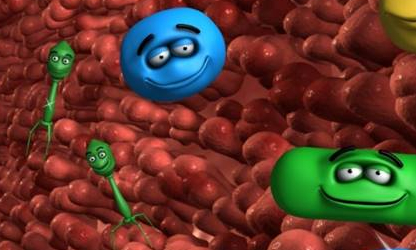

Wired Magazine
Wired Magazine
How Ravenous Soviet Viruses Will Save the World They're called phages. And they eat drug-resistant bacteria for breakfast.
By Richard Martin - October, 2003
As a child in the early '70s, Alexander Sulakvelidze dreamed of rising to the top of the Soviet scientific establishment. Fascinated by life at the smallest scales, he earned his PhD in microbiology from Tbilisi State Medical University in his hometown, the capital of Soviet Georgia. By the time he was 27, he was deputy director of the Georgian equivalent of the Centers for Disease Control and was collaborating with the Eliava Institute, a local hotbed of research in infectious diseases. He stood at the threshold of a brilliant career.
But when the Berlin Wall fell in 1989, the Soviet Union's formidable scientific infrastructure toppled along with it. By the early '90s, Sulakvelidze found himself laboring in a backwater. Like a Georgian Ginsberg, he watched the best minds of his generation go to waste.
"There was nothing left to do," he recalls. "Good scientists would come to work and spend all day playing cards and chess."
Determined to avoid that fate, he turned to the US. He applied for a National Academy of Sciences research fellowship at the University of Maryland Medical Center under Glenn Morris, one of the world's foremost epidemiologists. He got the nod, and in 1993 Sulakvelidze left Tbilisi for Baltimore.
He arrived to find the hospital in the midst of its own crisis. Enterococcus, a common bacteria that infests the human stomach and intestinal tract, was showing signs of resistance to vancomycin, the antibiotic of last resort. Between mid-'92 and mid-'94, vancomycin-resistant Enterococcus, or VRE, infected 75 patients, killing 6. A random sampling in fall '93 found that 20 percent of patients had VRE in their bloodstream. People were dying, and there was nothing anyone could do about it.
The Georgian microbiologist was nonplussed. Where he came from, infections were treated not only with antibiotics, but with viruses that attack and destroy bacteria. One day, as Morris lamented his inability to fight the outbreak, Sulakvelidze interrupted to ask: "Why don't you try bacteriophages?"
With that question, Sulakvelidze initiated a new phase in the age-old struggle between humans and microbes - one in which scientists are enlisting the power of evolution rather than fighting it.
The cause of the Maryland med center's sudden epidemic was no mystery. Wanton use of antibiotics, both in human patients and animals raised for food, reduces the danger of bacterial infection, but also forces bacteria to adapt at a prodigious rate. The germs that survive breed new generations of superbugs, impervious to even the most powerful medicines.
In an escalating arms race, scientists have scrambled to develop ever more potent drugs - but the bugs are winning. In January 2002, seven people died at a Tokyo hospital when they were infected with a drug-resistant strain of Serratia enterobacteria. The following March, all heart surgery at Scotland's Edinburgh Royal Infirmary was suspended after 13 patients came down with a methicillin-resistant strain of Staphylococcus aureus, the number-one cause of hospital infections. A month later, a 40-year-old diabetic woman in Detroit was found to be suffering from the first known vancomycin-resistant strain of S. aureus. Drug-resistant infections kill 40,000 people each year and account for up to $4 billion in additional treatment costs, according to the National Foundation for Infectious Diseases.
Where this leads is frightening to contemplate. A growing chorus of experts foresee a world in which formerly vanquished illnesses like tuberculosis and pneumonia rage out of control, and immune-compromised patients succumb to once-harmless infections.
"The war against bacteria is not something that can be won by humans," Sulakvelidze says. "If you try to wipe them out, they will always return. Only they will be stronger."
If the problem is classic Darwinian adaptation, the solution might lie in the very same process. Thus, Sulakvelidze, Morris, and others have turned their attention to bacteriophages, which have evolved over eons to destroy bacteria. This approach to fighting infection lets nature do the lab work usually carried out at tremendous expense, and with high failure rates, by the pharmaceutical industry. In contrast to engineered drugs, phages are as numerous and varied as the bacteria they attack. What's more, they evolve along with their prey, matching bacterial adaptation step by step.
The hard part, as Sulakvelidze and Morris have found, isn't harnessing them for medical benefit. Rather, it's bringing a dusty Soviet remedy into the 21st century.
The discovery of phages is lost in murky rivalries and scientific disputes. What's certain is that in 1917 an eccentric French-Canadian scientist named Félix d'Hérelle isolated them and named them bacteriophages - eaters of bacteria. Working independently, George Eliava discovered the minute creatures after collecting specimens from the Mtkvari River, which flows through the Georgian capital of Tbilisi. Eliava, head of the city's Central Bacteriology Laboratory, left a slide of river water containing cholera bacteria under a microscope for three days. When he returned, the germs were gone. Eliava surmised that something had destroyed them, and, like d'Hérelle, he set about isolating the tiny bacteria killers. Eventually, the Georgian struck up a fruitful collaboration with his French colleague. They worked together at the Pasteur Institute in Paris and later at the Institute of Microbiology, founded in Tbilisi in 1923 and later renamed in Eliava's honor.
It was there that a small band of scientists pioneered a new therapy, scrupulously assembling the world's only library of phages and developing cocktails of a dozen or more to treat a variety of bacterial disorders from stomach aches to pneumonia. Phages became part of the standard pharmacopoeia in the USSR, and they even enjoyed a brief heyday in the US, where Eli Lilly had an active phage-production program in the '30s. Soviet medics used the viruses on World War II battlefields, and soldiers with the German general Erwin Rommel carried phage treatments in disease-ridden North Africa.
The embrace of phages in the West didn't last long, though. American reviews of the Soviet research cast doubt on the therapy's efficacy, and when penicillin - widely regarded as a miracle drug - reached hospitals in 1941, Western doctors essentially forgot about phages. They continued to be sold in pharmacies throughout the Soviet Union, but the decline of medical research in the post-Soviet era nearly wiped out their use. By the 1970s, the Eliava Institute had fallen into a desuetude that threatened to bury five decades of research. Like Dark Age monks, the institute's scientists struggled to keep their phage library alive.
"One day at the Eliava, the electricity failed," write Michael Shnayerson and Mark J. Plotkin in their book The Killers Within: The Deadly Rise of Drug-Resistant Bacteria. "Over the next months, it went off more and more often, until in 1993 it stopped coming on at all. The researchers packed their home refrigerators with phages; those had power, at least, a few hours a day."
While many of his colleagues languished, Sulakvelidze brought the secrets of Soviet phage research to the US.
Scoop up a handful of water from the nearest creeK. Each milliliter holds about 200 million phages. Something like 1031 phages teem in the world's rivers, lakes, and oceans. That makes them, by some reckonings, the most abundant life-form in existence. As single-minded as they are ubiquitous, they exist only to replicate. The destruction of bacteria is simply collateral damage.
Unlike antibiotics, which attack bacteria indirectly by inhibiting cell wall synthesis, phages are cruise missiles that breach the wall and hijack the cell's reproductive machinery. So-called lytic phages reproduce like mad until the cell bursts, releasing hundreds of tiny clones. This reproductive capacity makes lytic phages ideal for human therapy. They're the only drug that, once in the bloodstream, replenishes itself until the infection is gone.
Phages have another important distinction: They come in innumerable variations, each targeting a specific kind of bacteria. A phage that attacks Salmonella ignores Staph aureus, and vice versa. That's both the beauty and the disadvantage of phages as therapeutic agents; unlike broad-spectrum antibiotics,which kill every bug in their path, viruses can wipe out pathogenic germs and "leave the good microflora alone," as Sulakvelidze puts it. On the other hand, phage-based drugs must be properly formulated to target the right bacteria.
The old Soviet phage preparations were both polyvalent (containing multiple phages to target several varieties of bacteria) and poorly characterized - even Eliava's scientists didn't know precisely what was in them. Sulakvelidze's challenge has been to develop an arsenal of viruses that can be combined in known quantities to eradicate specific bacteria. He and his Maryland team have assembled a library of monophages - preparations containing only a single phage strain - and sequenced their genomes, describing and classifying them to a level undreamed of by Eliava and his successors.
"It was not uncommon for a single preparation to have up to 17 targets," Sulakvelidze says of Soviet-era therapies. "How many phages in the preparation actually worked is anybody's guess. Now we know exactly what goes into our cocktails. When we need to reproduce one, we can make it exactly the same way."
To gather new strains, Sulakvelidze need only drop a bucket into Baltimore's Inner Harbor. The waters of the Chesapeake Bay, of which the harbor is an inlet, have enough exchange with the Atlantic that he can find a phage for almost any species of bacteria, he says. If one doesn't work, he simply refills his bucket and looks for another that does.
"This upgradability is one of the unique qualities of phages," Sulakvelidze adds. "Developing a new antibiotic takes 10 years and God knows how many millions of dollars."
As he puts it, "Mother Nature runs the best genetic engineering lab out there. No institution or company can match it."
Morris had heard of bacteriophages before his Georgian colleague mentioned them. The viruses had been used since the 1960s to transfer genes among bacteria, and they played a central role in the development of genetic engineering. But like most Western scientists educated in the era of antibiotics, he had never known them as a treatment for infection. As he and Sulakvelidze dug up the relevant literature - which, by Western standards, was scanty and slipshod - Morris became excited. Here, he realized, was an entirely different kind of weapon in the war against drug-resistant bacteria.
Sulakvelidze and Morris began to gather phages from the nearest source: Baltimore's harbor and the Chesapeake Bay. To pursue more rigorous studies, though, they needed money. In 1996 a tech investor named Caisey Harlingten, who had previously financed technical advances in opthalmology, formed a company to sponsor a collaboration between their lab and the moribund Eliava Institute. The Americans hoped to take advantage of Eliava's virus collection, phage-based medicines and decades of experience using phages in bug-infested military and hospital environments. As for the Tbilisi researchers, they were promised royalties and new hope for saving their precious phages.
But the deal soured when Harlingten appointed a new CEO, Richard Honour, to run the venture. Honour quickly decided to cut ties with the Eliava Institute and develop genetically modified phages in the US. Honour knew that the chances of gaining FDA approval for phage-based medicines developed and manufactured in Georgia were slight. Phages were available everywhere. Why tie the company to an aging Soviet-era research facility?
The rupture posed a dilemma for Sulakvelidze and Morris. To continue with Phage Therapeutics, as Harlingten's company was called, they would have to forsake the people who had carried the torch of phage research through the dark post-Soviet period, and who were Sulakvelidze's friends and countrymen. Moreover, the Georgian was adamantly opposed to genetically engineering phages: Why try to improve a weapon nature had honed over countless millennia?
"As much as I hate to say it, from a financial standpoint it makes little sense to establish a production facility in Tbilisi today," Sulakvelidze admits. "But we thought it was inappropriate to continue working with Harlingten. So we terminated our contract."
At that point, Sulakvelidze and Morris had an ongoing research program, a relationship with the Eliava Institute, a growing library of phages - and competition. In addition to Harlingten's Phage Therapeutics, a startup based on the work of NIH researcher Carl Merrill had emerged. An expert in gene transfer, Merrill first became fascinated by phages in the 1960s. In 1993, he began developing phage-based medicines for the newly formed Exponential Biotherapies.
With no company and little business experience, Sulakvelidze and Morris recruited four tech-savvy Baltimore entrepreneurs, who rounded up money to start a new firm, Intralytix, in 1998. Veteran tech exec John Vazzana, lured out of retirement to take over Intralytix as CEO, was charged with leading Intralytix through the desert of clinical trials, which would take years, to the promised land of earnings.
By 2002, it had become clear that the company needed a strategy that would buy time to bring Georgian medicines up to Western standards. Already the competition was faltering: In a delicious bit of irony, Phage Therapeutics had suspended operations. It would take some fancy footwork for Intralytix to avoid the same fate.
Vazzana's solution was as surprising as it was shrewd: He proposed that Intralytix focus not on humans, but on animals. The livestock population in the US numbers around 8 billion, including 7.5 billion chickens, 300 million turkeys, and 100 million cattle. During their brief, inglorious lives, these creatures receive as many as 10 different antibiotics, several of which are also used in human medicines. Some of these are therapeutic; when a few chickens become infected, growers treat the entire flock. The rest are used as growth promoters; animals on antibiotics stay healthier and grow faster. Unfortunately, the bugs infesting those antibiotic-saturated animals get smarter, making infections increasingly difficult to eradicate.
Government and industry have been slow to react, but they're starting to take action. The European Union recently banned the nonmedical use of antibiotics in animals, effective in 2006, and similar legislation is being considered in Washington. In February 2002, US poultry giants Tyson Foods, Perdue Farms, and Foster Farms began phasing out growth-promoting antibiotics.
Sulakvelidze is developing phage-based products that will help the industry moderate its use of antibiotics to treat disease as well. The first, designed to combat Listeria monocytogenes in poultry, was granted an experimental use permit by the Environmental Protection Agency in June 2002.
Of course, food-safety products are only a stepping stone to the real goal: a range of phage cocktails that would save the lives of people with currently untreatable infections. And, Sulakvelidze predicts, they'll likely be cheaper than antibiotics.
Which is not to say they're completely unavailable at present. Phage-based drugs are sold over the counter in Eastern Europe, and word of their efficacy has spread among Western victims of resistant infections. Given the FDA's glacial approval process for new drugs, that's a recipe for a black-market trade. Sure enough, North American patients are showing up in Tbilisi, hoping for a miracle. It's only a matter of time before phages are available in places like Bangkok and Tijuana.
"It's frustrating," Morris says. "As a clinician, I'd like to have phage products available in this country for my patients. Every time an article appears on phages, I get 50 emails saying 'Where can I get this stuff?' What am I supposed to tell these people?"
He might tell them that phages for human use are likely to be available in the US within five years, and that the bacteria-destroying viruses are already starting to be used on poultry farms and in processing plants. As Western science rediscovers a cure once thought obsolete, the day will come when viral remedies are found on stateside pharmacy shelves next to antibacterial soaps, and the golden age of antibiotics will give way to a renaissance of bacteriophages. And this time, the bugs could meet their match.
Cover Image - October 2003






